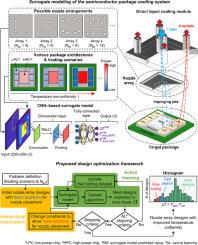Optimization framework for energy-efficient and uniform jet impingement cooling for heterogeneous integration packaging
IF 9.6
Q1 COMPUTER SCIENCE, ARTIFICIAL INTELLIGENCE
引用次数: 0
Abstract
The imbalance in heat power generated by various types of chips poses an obstacle to the reliability and performance of heterogeneous integration (HI) packaging technology, leading to excessive cooling that reduces the system's energy efficiency. We propose a framework to optimize the impinging nozzle arrangement for energy-efficient uniform jet cooling of HI packages. This framework utilizes a convolutional neural network (CNN)-based surrogate model that learns nozzle arrangements and heating scenarios to predict the temperature non-uniformity of the package. The potential optimal designs predicted by the CNN are used for re-training through an experimentally validated numerical analysis model. Combined with this active learning approach, the proposed hierarchical exploration algorithm accelerates optimization by gradually scaling the design options. The optimization results showed an increase in cooling uniformity by up to 39.5 %, while the cooling COP improved by up to 200 % across the investigated flow rate range (3–8 L/min). The optimized designs were experimentally validated with a maximum error of 4.34 % in average thermal resistance. Our framework achieved up to 45.7 % data savings compared to the random sampling-based approach. Along with a discussion on applying the CNN model to untrained conditions to further enhance optimization efficiency, our work represents a novel approach to broadly address the rapidly evolving diverse heating scenarios of HI, contributing to improved cooling energy efficiency in data centers and enhanced reliability of high-performance processors.

异质集成封装节能均匀射流冲击冷却优化框架
不同类型的芯片产生的热功率不平衡对异构集成(HI)封装技术的可靠性和性能构成了障碍,导致过度冷却,降低了系统的能效。我们提出了一个框架来优化碰撞喷嘴布置,以实现HI封装的节能均匀射流冷却。该框架利用基于卷积神经网络(CNN)的代理模型来学习喷嘴布置和加热场景,以预测封装的温度不均匀性。通过实验验证的数值分析模型,将CNN预测的潜在最优设计用于再训练。结合这种主动学习方法,提出的分层探索算法通过逐步扩展设计选项来加速优化。优化结果表明,在所研究的流量范围内(3-8 L/min),冷却均匀性提高了39.5%,冷却COP提高了200%。实验结果表明,优化设计的平均热阻最大误差为4.34%。与基于随机抽样的方法相比,我们的框架节省了45.7%的数据。随着对将CNN模型应用于未训练条件以进一步提高优化效率的讨论,我们的工作代表了一种新方法,可以广泛解决HI快速发展的各种加热场景,有助于提高数据中心的冷却能效和增强高性能处理器的可靠性。
本文章由计算机程序翻译,如有差异,请以英文原文为准。
求助全文
约1分钟内获得全文
求助全文
来源期刊

Energy and AI
Engineering-Engineering (miscellaneous)
CiteScore
16.50
自引率
0.00%
发文量
64
审稿时长
56 days
 求助内容:
求助内容: 应助结果提醒方式:
应助结果提醒方式:


